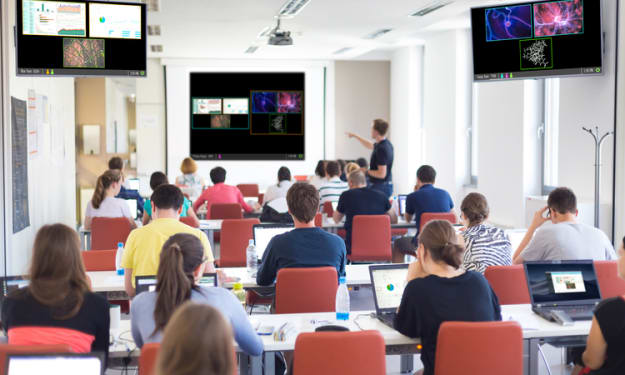Empowering Teachers with Technology in the UK
Teachers with Technology

In today's rapidly evolving digital world, technology has become an indispensable tool in various sectors, including education. For teachers in the UK, integrating technology into the classroom is not just about keeping up with trends but about enhancing the learning experience and preparing students for a tech-centric future. This article explores how technology empowers teachers, the challenges they face, and the promising future of tech-driven education in the UK.
The Current State of Technology in UK Education
The UK has seen a significant rise in the adoption of technology in classrooms. From interactive whiteboards to tablets, schools are increasingly recognizing the value of digital tools. According to recent surveys, nearly 70% of UK schools now use some form of digital technology in their teaching practices. Key technologies include learning management systems (LMS), educational software, and online collaboration tools, all aimed at making education more interactive and accessible.
Benefits of Technology for Teachers
Enhanced Teaching Tools
Technology provides teachers with advanced tools to enhance their teaching methods. Interactive whiteboards, for example, allow for dynamic presentations and real-time interaction, making lessons more engaging.
Improved Student Engagement
With educational apps and gamified learning platforms, students are more likely to participate actively. These tools cater to different learning styles, ensuring that all students can benefit.
Access to Online Resources and Professional Development
The internet is a treasure trove of educational resources. Teachers can access lesson plans, instructional videos, and forums to exchange ideas with peers. Online professional development courses also help teachers stay updated with the latest educational trends and technologies.
Challenges Faced by Teachers
Technological Barriers
Despite the benefits, integrating technology in the classroom comes with challenges. Not all schools have the necessary infrastructure, such as high-speed internet and modern devices.
Lack of Training and Support
Many teachers feel underprepared to use new technologies effectively. Without proper training and ongoing support, the potential of these tools cannot be fully realized.
Budget Constraints
Budget limitations often prevent schools from investing in the latest technologies. This disparity can lead to unequal access to quality education.
Successful Examples of Technology Integration
Several UK schools have successfully integrated technology into their curricula. For instance, the London Nautical School uses virtual reality (VR) to teach history, allowing students to experience historical events first-hand. Teachers at St. Peter’s Primary School have reported increased engagement and improved learning outcomes after incorporating tablets and educational apps into their lessons.
Government Initiatives and Support
The UK government has recognized the importance of technology in education and has introduced several initiatives to support its integration. Funding programs such as the EdTech Demonstrator Programme provide schools with the resources and guidance needed to adopt new technologies. Additionally, policy changes aim to promote digital literacy from an early age.
Popular Educational Technologies
Interactive Whiteboards
These have become a staple in many classrooms, enabling teachers to present information dynamically and interactively.
Learning Management Systems (LMS)
Platforms like Moodle and Google Classroom help teachers manage coursework, assignments, and communications with students and parents efficiently.
Educational Apps and Software
Apps like Kahoot! and Duolingo make learning fun and interactive, catering to various subjects and skill levels.
Virtual Reality (VR) and Augmented Reality (AR)
VR and AR are being used to create immersive learning experiences, from virtual field trips to interactive science experiments.
Professional Development for Teachers
Online Courses and Webinars
Teachers can enroll in online courses and webinars to learn about the latest technologies and how to implement them in their classrooms.
In-School Training Programs
Schools are increasingly offering in-house training sessions to ensure that all teachers are comfortable using new tools.
Teacher Communities and Forums
Online communities and forums provide a platform for teachers to share experiences, ask questions, and get support from their peers.
Future Trends in Educational Technology
Artificial Intelligence (AI) in Education
AI can provide personalized learning experiences, adapting to each student's needs and pace.
Gamification
Incorporating game elements into learning can boost student motivation and engagement.
Personalized Learning
Technology allows for more personalized learning paths, catering to the unique needs and abilities of each student.
Implementing Technology in the Classroom
Step-by-Step Guide for Teachers
- Assess Needs and Goals: Determine what you want to achieve with technology.
- Choose the Right Tools: Select technologies that fit your needs and budget.
- Get Trained: Attend training sessions or online courses.
- Start Small: Begin with a pilot program before scaling up.
- Gather Feedback: Regularly collect feedback from students and adjust as needed.
Best Practices
Integrate technology seamlessly into lessons rather than making it the focus.
- Ensure all students have access to the necessary devices and internet.
- Continuously update your skills and stay informed about new technologies.
- Common Pitfalls to Avoid
- Avoid using technology for the sake of it; it should enhance learning.
- Don't neglect traditional teaching methods that work well.
- Ensure data privacy and security for all users.
Student Perspectives on Technology in Education
Students generally respond positively to technology in the classroom. Many report that digital tools make learning more enjoyable and accessible. They appreciate the interactive nature of educational apps and the ability to learn at their own pace.
Chemistry Assignment Help: Your Guide to Excelling in Chemistry Assignments
Native expert offer Chemistry assignment help services invaluable support to students grappling with complex chemistry concepts and assignments. Whether you're struggling with balancing chemical equations or crafting detailed lab reports, professional assistance ensures clarity and accuracy in your work. Chemistry Assignment helper Provide expert guidance, resources, and personalized tutoring to help you excel in your chemistry studies, boosting your understanding and academic performance."
Parental Involvement and Technology
Engaging Parents in the Digital Learning Process
Parents play a crucial role in supporting their children's education. Schools can engage parents through regular updates, online portals, and workshops on digital literacy.
Tools for Parents to Support Learning at Home
Providing parents with resources and tools, such as educational apps and websites, can help them support their children's learning outside of school.
Measuring the Impact of Technology in Education
Metrics and KPIs
To measure the effectiveness of technology in education, schools can track various metrics such as student engagement levels, academic performance, and teacher satisfaction.
Studies and Research Findings
Research has shown that when implemented effectively, technology can significantly enhance learning outcomes. Studies indicate improvements in student motivation, understanding of complex concepts, and overall academic performance.
Ethical Considerations
Data Privacy and Security
With the increasing use of technology, ensuring the privacy and security of student data is paramount. Schools must adhere to data protection regulations and implement robust security measures.
Digital Equity
It's essential to address the digital divide and ensure that all students have equal access to technology, regardless of their socioeconomic background.
Conclusion
Empowering teachers with technology in the UK is crucial for modernizing education and preparing students for the future. While challenges exist, the benefits far outweigh the drawbacks. With the right support, training, and resources, teachers can harness the power of technology to create more engaging and effective learning experiences.
About the Creator
Harry Smith
I have been working as an academic writer for the last five years at Native Assignment Help UK, specializing in providing outstanding Accounting Assignment Help and our Experts is experienced in tailors high-quality assignments
Enjoyed the story? Support the Creator.
Subscribe for free to receive all their stories in your feed. You could also pledge your support or give them a one-off tip, letting them know you appreciate their work.






Comments
There are no comments for this story
Be the first to respond and start the conversation.